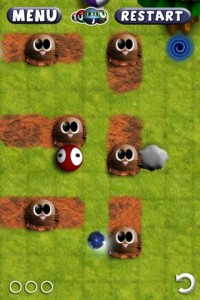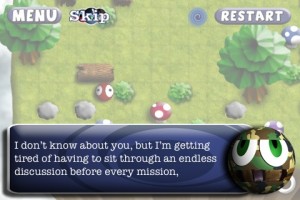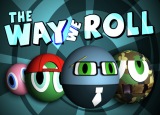We love us some logic puzzles, so suffice it to say we’re pretty excited about Polar Bird Studio‘s upcoming puzzle/adventure debut The Way We Roll. Here’s our chat with designer and graphic artist Brian Hobbs, and programmer Paul Dumas, to find out more about the project.
Tell us a little about how you and Paul met up and decided to form Polar Bird Studio. Is The Way We Roll the first game development experience for both of you?
Brian: I think we tried to make a game using Visual Basic when we were about 10 or so. And by “tried,” I mean that I designed maybe three levels and he got a square block to move around the screen using the arrow keys. Riveting, yes?
Growing up together, Paul Dumas and I both enjoyed playing a variety of video games, and myself having a penchant for creating things, I designed upwards of 15 games just on paper. As we grew older, the idea of making games got thrown into the pile of “stuff we should totally do someday,” like starting a band, taking a road trip, or robbing a casino; which means that it would be really awesome, but would also require a lot of time and work, skills and resources we didn’t have, and a crew of eleven professional thieves.
Flash forward to a little over a year ago. We’re both married, and I have my first child on the way. I graduated with a degree in Film and Video, and specialize in motion graphics, while Paul has spent some time dabbling in a few programming languages. One day I am telling Paul about a puzzle I designed as a hobby.
 I say, “I wish there was some way I could know for sure if there was only one solution to this puzzle.”
I say, “I wish there was some way I could know for sure if there was only one solution to this puzzle.”
“I’ve been learning the Python language, and could probably make a program that would tell you,” he says.
After he successfully programs such a solver, complete with a graphical interface, I muse, “You know, I know about graphics, animation, and puzzles, and you know a lot about programming. Are you thinking what I’m thinking?”
“We should make a graphic-designing, puzzle-solving robot?” he might have asked.
“No,” I would have said. “We should make a game.”
And Polar Bird was born, with The Way We Roll as our first venture.
What were some of your influences when designing the game’s ball sliding style and the player’s ability to subtly reconfigure its environments? Was this your gameplay vision from the very beginning, or did it gradually evolve as you developed other aspects of the game?
Brian: Everything in the game started with the initial puzzle mechanic. That puzzle I mentioned before, that Paul made a solver for, was the same mechanic that the game uses. In fact, we even included that very puzzle as one of the secret levels in the game. It was originally presented as a marble making its way through a maze of wooden blocks, but once we began work on the game, I knew I wanted to beef up that concept considerably, creating a world and characters within that world, so I pretty much just turned that marble into a round character and we went from there.
For the environments, as I began thinking through variations and additions to the puzzle elements, that evolved fairly naturally. We wanted to include a sense of player exploration and interactivity, so we designed with that goal in mind, from the zooming and panning in the levels, to the simple touch controls, to the elements that move and change as you and/or the character interact with them.
 What’s your approach to generating good logic puzzles? How does one even get practiced in something like this to the point that you’re able to make a full-fledged videogame out of it – did you guys find that you simply had a knack for it after playing a lot of puzzle games, or was puzzle design a long-running hobby for either of you before starting The Way We Roll?
What’s your approach to generating good logic puzzles? How does one even get practiced in something like this to the point that you’re able to make a full-fledged videogame out of it – did you guys find that you simply had a knack for it after playing a lot of puzzle games, or was puzzle design a long-running hobby for either of you before starting The Way We Roll?
Brian: Puzzles were a major hobby of mine all the way through growing up, and still are. I have a decent collection of old, ratty puzzle books taking up space in our bookshelf, much to my wife’s chagrin. What I enjoy most are puzzles that require logic, but also require creativity, lateral thinking, and ingenuity both to create and to solve. Puzzle video games are a great medium for that kind of thing. I played through the Myst series more times than should be admitted publicly.
As for my approach to puzzle design, I usually start each level with a concept of some kind. It could be a geometric shape or pattern, like a clover leaf or a QR code. Or it could be some kind of conceptual puzzle element or system, like a level that acts mechanically like a series of canal locks, or one that purposely tries to lure the player down the incorrect path. Once I have that concept down, I carefully place each element in line with the theme, and try to keep a handle on making sure there isn’t some kind of shortcut to the puzzle that makes it much easier than intended.
 We don’t normally expect much story in a logic puzzle game beyond the setup, but it looks like The Way We Roll will take things to the next level. What’s your philosophy on this – what made an interesting narrative such an important goal to achieve in this project?
We don’t normally expect much story in a logic puzzle game beyond the setup, but it looks like The Way We Roll will take things to the next level. What’s your philosophy on this – what made an interesting narrative such an important goal to achieve in this project?
Brian: I believe that storytelling is one of the “lifebloods” of culture. From cave paintings, to the parables in the Bible, to the movies and TV shows of today, stories inspire us, inform us, and reflect our culture, our perspective, and our values. The games that I’ve found to be most memorable are the ones that were strong in the storytelling department, from the epic struggle of good versus evil in Final Fantasy VII, to the intriguing tale of greed, ambition, and corruption in the Myst series, to the subtler, more mysterious storytelling in games like Shadow of the Colossus and Limbo.
For The Way We Roll, I wanted to go beyond the frivolous and bare-bones stories of other puzzle games, like “Help Skippy the squirrel get his acorns back from the evil bird Beakazor,” and do something a lot more fleshed out, complete with multi-dimensional characters and plot twists. It plays out in a rather light-hearted and humorous way, but actually has a lot of depth and mystery that will unfold gradually as you play.



